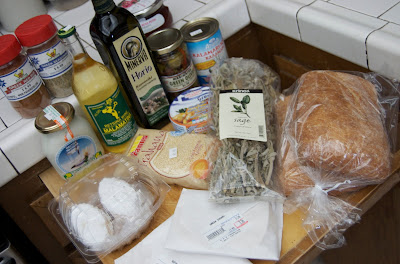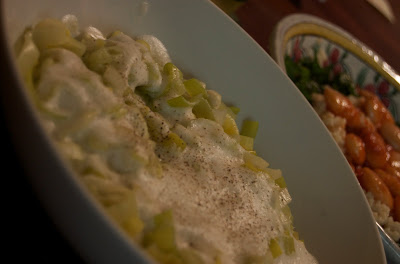Just between you and me and the gatepost–as my grandma used to say–I’m getting a little weary of trying to sort out the differences between Mediterranean and Middle Eastern cuisines. So much of it is so similar that when I ask, “What’s the difference between your stuffed grape leaves and those of the country next door?” the inevitable response is, “Ours are better.”
I yearned to do something a little different this time, so I headed out for groceries, not to the generic corner market but to Papa Cristo’s on Pico at Normandie in Mid-City Los Angeles. This beloved LA institution is a Greek grocery, restaurant and catering company that keeps the city’s Greeks–and Greek food lovers–supplied with plenty of imported and authentically prepared food.
Here’s my haul, which I used to make dinner, with plenty of items I can use for quite some time–a good olive oil, some seasonings to which only Papa Cristo himself knows the formula and a nice bag of Greek sage that’s still on its woody stems. And masticha, which we’ll get to in a little bit.
What I didn’t want to do was make what shows up on every Greek menu–or what people typically think of when they ponder Greek food. So no hummus, no baba ganoush, no baklava.
Instead of feta, which is what usually comes to mind when you think of Greek cheese, I selected wedges of a couple of completely different cheeses to go with the rustic bread that’s made on-site. The cheese in the center is kaseri, a sheep’s milk cheese with a little goat’s milk thrown in for good measure. It has an herbal quality to it that I suppose is the result of grazing livestock in a scrubby landscape filled with rosemary, thyme and oregano. Its slight chewiness reminds me a bit of provolone. The cheese in the lower right is kefalotiri, a tart, saltier and slightly drier cheese made from sheep’s milk. Having been around since Byzantine times, this is a cheese with some history. By the way, its name comes from the Greek hat called a kefalo. Now whenever I see one those hats, my wacky mind’s eye is sure to envision someone wearing a round of cheese on his head.
Okay, so the canned beans seem like a cheat, but they’re Greek gigantes, the largest lima beans you’ll ever find. One glance and I’d swear they were actually fava beans, but they taste like neither limas nor favas. They have a mild flavor and with a slightly dry texture to them–in spite of their tenure in the can of sauce–so the mildly spicy red sauce was a good addition. I cooked up some of the couscous-type sour frumenty Greek pasta. It’s made of durum wheat and has a robust sourdough flavor. Then I started layering: I spooned the hot pasta and beans over a bed of chard and let it wilt, then drizzled the dish with the olive oil and a little red wine vinegar (not too much, since the pasta is naturally sour) and sprinkled on one of Papa Cristo’s spice blends. Served with bread and olives, it was a satisfying main course. With it we had glasses of retsina. This Greek white wine is famously pine-tasting, crisp and dry, but full of flavor.
I made up a bit of ladolemono to dip them in. This intensely lemony dressing is a popular accompaniment in Greece to all sorts of seafood. It’s a great addition to your stash of quick fix-ups–just whisk together a couple of tablespoons of fresh lemon juice, a half tablespoon of Dijon mustard and a quarter cup of olive oil, and season it with salt and black pepper to taste. This sauce has some serious pucker power, so cheat if you need to, by adding just a smidge of sugar while you’re whisking to make the sauce a little less aggressive.
Snack time: People love their “spoon sweets” in Greece, and masticha is a favorite. Growing only on the southern part of the island of Chios, the evergreen mastica tree produces a pleasantly resinous tasting sap that is used to flavor this yummy paste. Get a spoonful of this white taffy-like substance and dip it into a glass of water to make a “lollipop” of it, called a “submarine.” It’s a great treat on a hot day. While masticha looks like it might be employed in some other way in the kitchen, this is the only way I’ve ever heard of anyone eating it. Hmmm, looks like an ingredient that’s just begging to be experimented with, doesn’t it?
For breakfast the following morning we toasted some of the leftover rustic bread and enjoyed it with the cheeses and some rose petal preserves. I was still swooning from the rosewater ice cream I’d had during my Persian adventure the previous week, so a rose petal strewn breakfast made me quite happy.
For future reference, rose petal preserves are quite liquidy and don’t work well on rustic bread with its large crumb (that’s baker talk for holes in the bread created during the rising process). It leaks through and you have to lick it off your plate. It’s also difficult to photograph as it seeps through, so I’ll just have to document it this way, with those luscious petals sliding off the spoon.
Yeah this is Greek-lite, I know. But it was fun poking around in the market, reading labels and becoming overwhelmed by the variety of food available. When you’re dealing with a cuisine that is several thousand years in the making, your choices are practically unlimited.


























This looks so wonderful! Thank you for the variety–hoping to try some of these dishes myself someday.